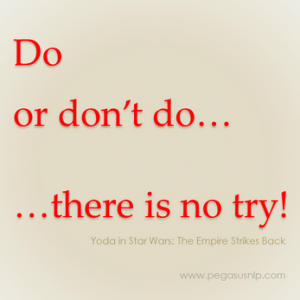- ‘Try’ implies failure

What have these got in common?
- We must try and meet up again
- I’ll try and lose weight
- Try and get this done on time
- Let’s try not to worry about this
In each case the word try implies
- I don’t want to meet you again
- I don’t believe I’ll lose weight
- I don’t believe you’ll get it done on time
- We’re going to worry about this – lets be realistic.
Try implies failure. We use it when we assume or expect to not succeed. If we truly believed we could succeed we would not slip it in!
How it works
Compare the two requests:
- Try and touch your right ear
- Try and touch the ceiling without standing on a chair
In the first request there is no point in using try since you can just reach up and touch your ear – assuming you have no physical restrictions.
In the second using try seems perfectly reasonable since it’s unlikely you can do it – assuming the ceiling is the usual height.
Avoiding commitment
We tend to use try as a way of avoiding commitment. And as a way of saying ‘I really don’t believe I can do this – but I’ll make a half-hearted attempt…’
If we were fully committed we’d say ‘Yes, I’ll do it.’ However if I slip in a sneaky little ‘try’ and then don’t succeed I can always say ‘I knew it’d be too difficult – but at least I tried.’
With my get-out clause of try you can’t blame me. Failure is not only expected, it’s respectable. ‘I only said I’d try’!
When it’s fine to use it
Yes, there will be times when it’s fine to use the word – when failure is not implied. Such as the ‘experimental try’
- Try this food
- Try on those shoes
- Let’s try this new sport!
Here there’s no expectation of failure.
How using ‘Try’ conditions us
It’s interesting how try emotionally affects us. Try(!) an experiment: pick something you would like to do such as increase your fitness, do that DIY job or complete a work project. Make this something that can be done in the next week.
Round 1: Now close your eyes, think of the task, and say ‘I’m going to do this’ and keep them closed for 30 seconds – as you pay attention to the images, thoughts or feelings this evokes.
Now stand up or move about to change your state.
Round 2: Close your eyes, think of the task, and say ‘I’ll try and do this.’ And again take 30 seconds to recognise the images, thoughts and feelings.
You’re likely to notice a quite different set of reactions to the two statements.
The second round usually produces a vague and quite relaxed response. After all it’s no big deal if I fail.
The first round usually evokes a mixture of determination and, naturally enough, doubt. Keep the determination. And recognise the doubt as a signal that you need to have an action plan to support your determination.
Just commit
For the next seven days replace the ‘I’ll try’ with ‘I will do it’. And notice what difference it makes.
If it helps to keep you on track at reducing your use of the word ask friends, family and co-workers to impose a small fine for every transgression. And donate the week’s total to your favourite charity.
In Star Wars Yoda suggests:
‘Do – or do not. There is no try’
There is another blog article here: https://nlp-now.co.uk/beneath-the-words-nlp-try